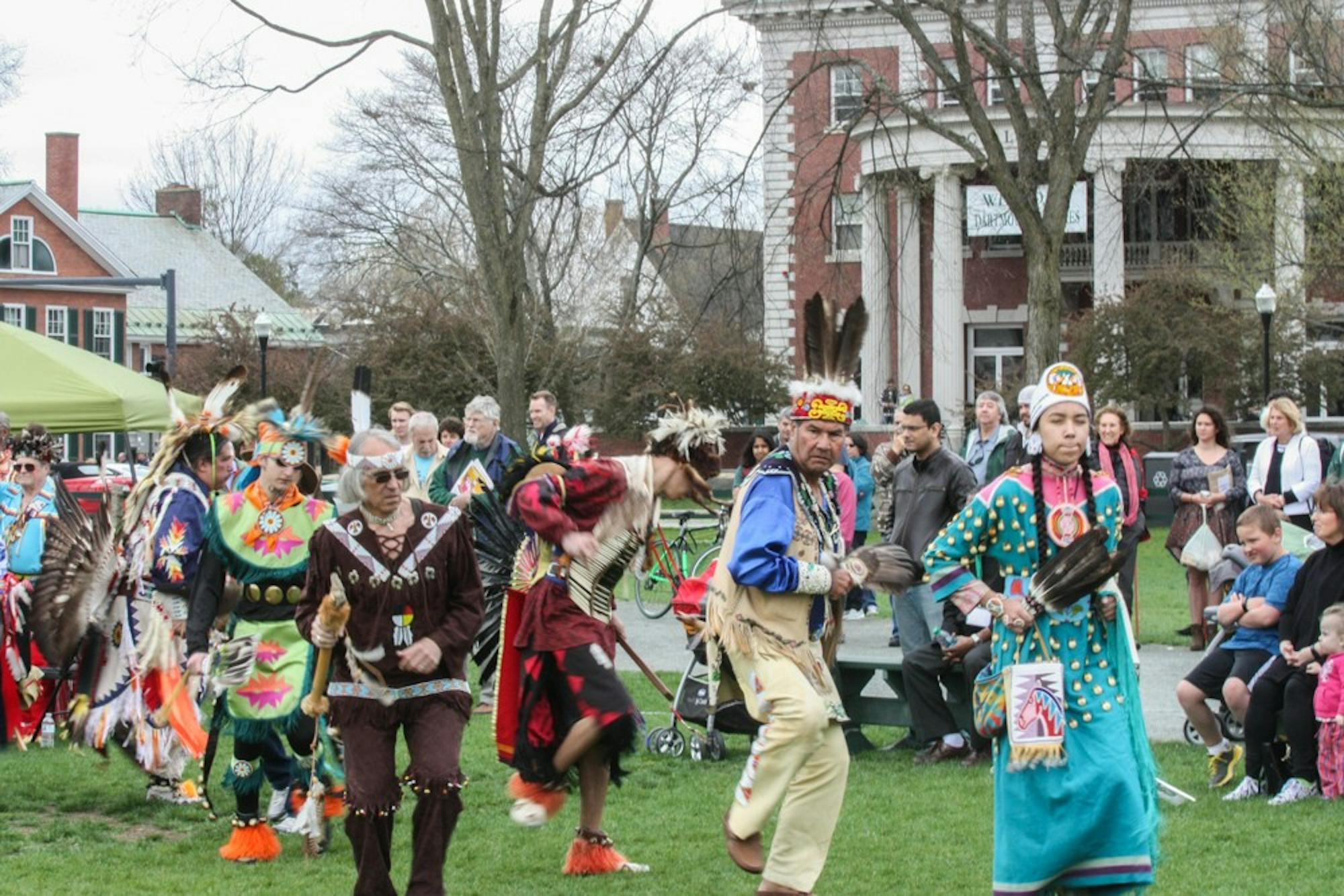Dancers in Native American regalia took center stage at the 44th annual Dartmouth Powwow. Performers dressed in beautiful beads and golden bells swirled and spun on the performance grounds, captivating the crowds in the stands. A heartbeat-like drum rhythm resonated throughout the area, audible from hundreds of meters away.
The annual Dartmouth Powwow is a two-day celebration that first began in 1973. Andrew Shipman ’18 and Marina Van Pelt ’18 co-chaired the committee that oversees the event, sponsored by a variety of organizations, including Native Americans at Dartmouth, the Native American Program, the Native American Alumni Association at Dartmouth, the Office of the President and the Special Programs and Events Committee.
The Dartmouth Powwow drew participants from around the country, including those from many different tribes. Each tribe has a distinct style of dress, and with the mix of traditional and contemporary colors, each traditional dress regalia was unique. The components of a dress regalia are often handmade by the wearer himself or herself or passed down from prior generations.
“This regalia is something my cousin passed down to me,” Reed Two Bulls, a dancer in the Fancy Shawl category, said. “Usually, you bead your own pieces or have your mother do it. With the colors, it’s mostly just personal.”
The complex components of the dress regalia can be difficult to control during the dances.
“I would say making sure everything is on very tightly is one of the most important things,” Two Bulls said.
The Native regalia worn by the men and women have unique features. A distinct feature of menswear includes a breechclout, a rectangular-shaped piece of cloth worn over the belt. Leggings are common, especially those made of leather or fur. For women, the basis of the regalia usually consists of a skirt and leggings. Special regalia elements include shields, rattles, breastplates, headdresses and dance sticks. These are unique to the dress and often gifted to the dancers by loved ones or tribal leaders. Dance regalia is not static — many times, the pieces take years to make, and additions are made throughout the dancer’s lifetime.
The Poncas, a Native American tribe in the Midwestern region that currently largely reside in Nebraska and Oklahoma, are credited with the creation of the first powwow in the early 1800s. The Plains tribe, a tribe from the Great Plains region, developed what became the modern-day powwow in the 1920s. Powwows fall under two general categories – “contesting,” a form in which participants dance competitively for prizes, and family-oriented events, a non-competitive form.
Men and women compete in two separate categories. For men, the categories of dance are typically Fancy Dance, Northern Traditional, Southern Straight and the Modern Grass. For women, categories typically include Traditional Buckskin or Cloth, Fancy Shawl and Jingle Dress.
Many of the audience members, although unfamiliar with the styles of dance, appreciated them just the same.
“The announcer said that one of the dances was meant to emulate a butterfly, and I think the dancer did a great job of that,” April Liu ’18, an audience member, said.
Some dances can be learned by watching others, while other tribes teach their dancers. In the case of Two Bulls, she learned by going to powwows and watching other dancers.
Drumming serves central to the powwow. Among the many drummers, there is a host drum, one that has authority and is greatly respected. The drumbeats serve as the foundation for the vocals, typically comprised of singing or chanting, or a combination of both.
Over 20 vendors surrounded the performance area, offering a wide variety of products, including hand-woven baskets and fur articles. One particularly popular vendor offered frybread, a round disk of unsweetened fried dough, a common yet relatively recent food in Navajo culture. The history of the frybread reflects the history of its creators — it was an invention of necessity, a creation that used the government-issued white flour and lard when traditional foods such as vegetables and beans were not available on relocated land.
A vendor from The Wandering Bull Inc., offered wool blankets with traditional patterning and a variety of colorful beads. Beading is a time-intensive method of embellishment that many people employ on the various pieces of their regalia. Many of the dancers had elegant beadwork adorning their moccasins.
“This powwow is interesting, because it brings together many different tribes; you can tell from their regalia,” Chris Bullock, owner of The Wandering Bull Inc., said.
Bullock was wearing regalia with deep red as the primary color. He noted that the handmade vest with intricate brass beading was added later.
“There’s a mix between the more traditional hues in regalia, like mine, and the brighter colors of more modern pieces,” Bullock said.
These many forms of art – including dance, regalia, music and singing – bring the campus and the Upper Valley community, as well as tribes from around the country, together every year during the powwow and offer a diverse and multifaceted perspective on the nature of Native American art.




